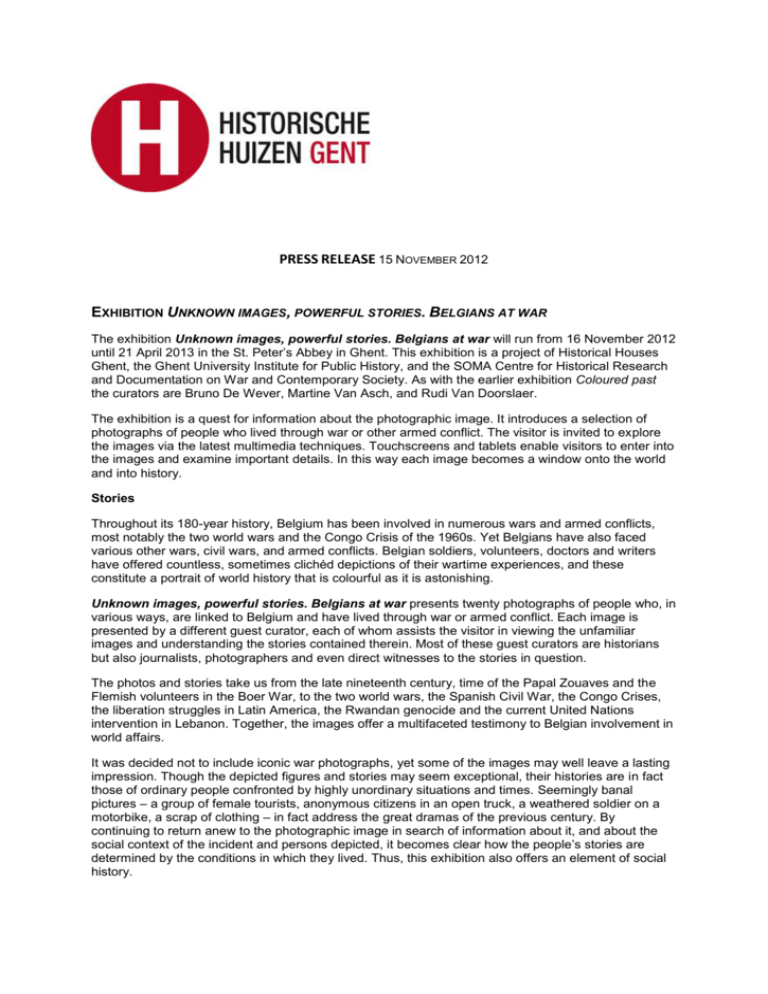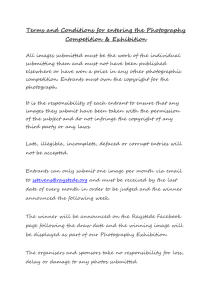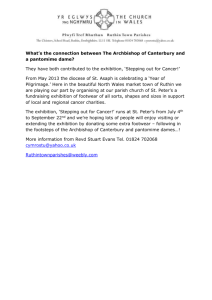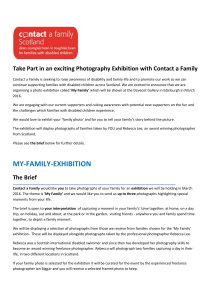press release - Sint-Pietersabdij
advertisement

PRESS RELEASE 15 NOVEMBER 2012 EXHIBITION UNKNOWN IMAGES, POWERFUL STORIES. BELGIANS AT WAR The exhibition Unknown images, powerful stories. Belgians at war will run from 16 November 2012 until 21 April 2013 in the St. Peter’s Abbey in Ghent. This exhibition is a project of Historical Houses Ghent, the Ghent University Institute for Public History, and the SOMA Centre for Historical Research and Documentation on War and Contemporary Society. As with the earlier exhibition Coloured past the curators are Bruno De Wever, Martine Van Asch, and Rudi Van Doorslaer. The exhibition is a quest for information about the photographic image. It introduces a selection of photographs of people who lived through war or other armed conflict. The visitor is invited to explore the images via the latest multimedia techniques. Touchscreens and tablets enable visitors to enter into the images and examine important details. In this way each image becomes a window onto the world and into history. Stories Throughout its 180-year history, Belgium has been involved in numerous wars and armed conflicts, most notably the two world wars and the Congo Crisis of the 1960s. Yet Belgians have also faced various other wars, civil wars, and armed conflicts. Belgian soldiers, volunteers, doctors and writers have offered countless, sometimes clichéd depictions of their wartime experiences, and these constitute a portrait of world history that is colourful as it is astonishing. Unknown images, powerful stories. Belgians at war presents twenty photographs of people who, in various ways, are linked to Belgium and have lived through war or armed conflict. Each image is presented by a different guest curator, each of whom assists the visitor in viewing the unfamiliar images and understanding the stories contained therein. Most of these guest curators are historians but also journalists, photographers and even direct witnesses to the stories in question. The photos and stories take us from the late nineteenth century, time of the Papal Zouaves and the Flemish volunteers in the Boer War, to the two world wars, the Spanish Civil War, the Congo Crises, the liberation struggles in Latin America, the Rwandan genocide and the current United Nations intervention in Lebanon. Together, the images offer a multifaceted testimony to Belgian involvement in world affairs. It was decided not to include iconic war photographs, yet some of the images may well leave a lasting impression. Though the depicted figures and stories may seem exceptional, their histories are in fact those of ordinary people confronted by highly unordinary situations and times. Seemingly banal pictures – a group of female tourists, anonymous citizens in an open truck, a weathered soldier on a motorbike, a scrap of clothing – in fact address the great dramas of the previous century. By continuing to return anew to the photographic image in search of information about it, and about the social context of the incident and persons depicted, it becomes clear how the people’s stories are determined by the conditions in which they lived. Thus, this exhibition also offers an element of social history. Unknown images, powerful stories. Belgians at war seeks especially to ask questions. Do the pictures actually convey the reality of war? Do they truly render the horrors of armed conflict? And what can be said about the act of looking at photographs (or moving images)? Effectively analysing historical images is as difficult as it is important. Just as with any other historical documents, photographs of historical events must be approached with adequate caution. Often, having read the background stories or listened to the additional commentaries, there arises a tension between one’s first reading of a picture and the second or third. What does this tension say about the value of our contemporary visual culture and about the information we consciously and (especially) unconsciously retain in this way? The exhibition and its accompanying book contribute to a critical appreciation of visual sources about the past. Evolution From the start, photography was labelled as a means by which to accurately and objectively capture reality. As technology evolved, however, people increasingly came to recognize that the photographer is in fact an interpreting subject. Photographs provide access not to reality, but rather to an encapsulated image of it. The photographer thus influences the final image in numerous ways. Even the selection of subject matter and the degree of framing are determined, thereby rendering both the photographer and his or her client quite influential. Photographic images are always embedded within a particular context, and this context influences the picture’s meaning. In the early twentieth century the technical evolution of photography received a huge boost thanks to introduction of the hand camera. Photography now became part of ordinary life. This democratization of the photographic process benefitted war photography as well, as now anyone with a relatively limited amount of technical knowledge and equipment could take pictures. This evolution in photography makes it is possible to present an exhibition such as this. The popularization of the medium made it possible to show, via photographs, that war can happen anywhere and that photographs can bear witness regardless of who takes them. In some circumstances, people are simply unable to escape war, even when they greatly desire to do so (as is usually the case). This is why this project sought to bring together photographs of diverse types and subjects. The exhibition Unknown images, powerful stories. Belgians at war presents photographs taken by professional photographers working for a military government or judicial system, by witnesses who sought to capture images of friends or associates, by random passers-by who would not have realized what their image might mean for posterity, by print journalists unaccompanied by a professional photographer, by street photographers who earned a living by capturing images of everyday life. This journey through almost a century and a half of history would never have been possible without the ever-increasing accessibility of photography. Moreover, it seems that museums hardly ever present these sorts of ‘everyday’ images created by everyday photographers. Photography exhibitions rarely escape the tendency towards aestheticisation, and so the important questions which this exhibition seeks to ask are rarely if ever addressed. In essence, Unknown images, powerful stories. Belgians at war assesses the significance of and underlying the photographic image. This is undertaken through the perspective that the ever-growing importance of visual culture remains, in the year 2012, an essential element in the critical evaluation of our society. The guest curators Many of the selected photographs appear, at first glance, deceptively simple. Detailing the stories behind each image required a significant amount of research, and so the exhibition’s curators elected to collaborate with twenty guest curators: Thomas Buerman wrote, at Ghent University, a thesis on "Catholic masculinities in Belgium in the 19th and 20th centuries". He offers the visitor a glimpse into the world of the Zouaves. Chris Schoeman is a South African historian; his book "Brothers in arms: Hollanders in the AngloBoer War" was published in 2012. He takes visitors into the world of the pro-Flemish activist Maurice Josson. Patrick Nefors is archivist at the Royal Army Museum in Brussels. He introduces us to, among other things the logistic machinery that arose during WWI. Johan Lagae, of Ghent University, is a specialist in urban history and architecture in central Africa. He presents colonial Lubumbashi in 1917. August Thiry teaches journalism at the Katholieke Hogeschool Mechelen. He co-authored, with Dirk van Cleemput, "Travellers through the Great War: the odyssey of a Belgian armoured corps 19151918", which was published in 2008. He brings us into the adventures of the Belgians who in the First World War went with the armoured corps to Russia. Emmanuel Debruyne is associated with the UCL, where he specializes in the history of the resistance and the intelligence services during the two world wars. He introduces us to the tragic resistance fighter Guillaume Joseph Valleye at the end of World War I. Nicolas Mignon is associated with the UCL. For this exhibition he introduces a piece of forgotten history about the Belgian occupation of Germany. Rudi Van Doorslaer is the director of SOMA. He presents visitors a photograph of female volunteers in the Spanish Civil War. Pieter Jan Verstraete publishes mainly on the history of the Flemish Movement and collaboration during the Second World War. For this exhibition, he relates the story of Marcel Vercoutter, who volunteered to fight for the Waffen-SS. Lieven Saerens, a scholar at SOMA, is a specialist in the history of the judeocide. In this exhibition he analyses a photograph taken in Antwerp during the war years. Pieter Serrien launched the historical research centre Collective Memory two years ago. He introduces visitors to the bombing of Mortsel in April 1943. Chantal Kesteloot is head of the SOMA’s Department of Public History and a specialist in the history of the Walloon movement and the question of Brussels. She presents for discussion the wartime assassination of the prominent Belgian collaborator Paul Colin. Ward Adriaens, former director of the Jewish Museum of Deportation and Resistance in Mechelen, introduces viewers to Maria Liekens, one of the partisans from Heist-op-den-Berg. Fabrice Maerten, head of the SOMA’s Documentation Department, is an expert in the history of the resistance movement and the Catholic world in Belgium during the Second World War. He introduces visitors to the drama that unfolded in Wodecq, in Wallonia, at the end of World War II. Jacques Déom is affiliated with the Fondation de la Mémoire contemporaine (ULB-CIERL). He relates the personal story of Joseph Blitz during the Israeli War of Independence. Florence Gillet heads the unit Image and Sound at the SOMA and specializes in colonial history. She takes us to Stanleyville, now Kisangani, in northeastern Congo, in 1964. Willem De Witte discusses his brother Michael, who departed to El Salvador as a volunteer in September 1982 Teun Voeten, a photographer, testifies about his repatriation from Kigali in April 1994. Chris De Stoop, an investigative journalist, initiates us into the research he conducted on Muriel Degauque, the first (and so far only) Belgian female suicide bomber. Jens Franssen, a journalist for VRT, offers us a glimpse into the delicate yet perilous efforts of Belgian mine clearance experts. Visiting the exhibition Individuals and groups may reserve their tickets via BoekjeBezoek- Gent Cultuurstad vzw (telephone: 09 267 14 66). Ticket reservation is not mandatory, but will guarantee a smooth access at busy times. For those interested in reading further about the exhibition, the curators (Bruno De Wever, Martine Van Asch and Rudi Van Doorslaer) have edited an accompanying book, Onbekende beelden, sterke verhalen. Belgen in oorlog, published by Hannibal Publishing. Available in Dutch and French. For schools, a lesson and DO package is available for primary grade 3 and secondary grade 1. Available in Dutch. The website www.sintpietersabdijgent.be offers more information about Unknown images, powerful stories. Belgians at war and about the Off-program developed to accompany to the exhibition. PRACTICAL INFO Historische Huizen Gent (Historical Houses Ghent) Sint-Pietersabdij (St. Peter’s Abbey) Sint-Pietersplein 9 9000 Ghent T +32 (0)9 243 97 30 F +32 (0)9 243 97 34 E sintpietersabdij@gent.be www.sintpietersabdijgent.be Fabienne Gros Press and communication T +32 (0)9 243 97 52 E fabienne.gros@gent.be ADMISSION € 8: individual visitor € 6,75: reduced rate Free: children and young people (ages 18 and under) € 1: visitors 19-25 years old Open Tuesday through Sunday, from 10:00 to 18:00 Closed Mondays. Closed: December 24, 25 and 31 and January 1 PUBLICATION ‘Belgen in oorlog. Onbekende beelden, sterke verhalen’ price: € 29, 95 – Hannibal Publishing





